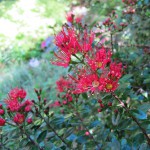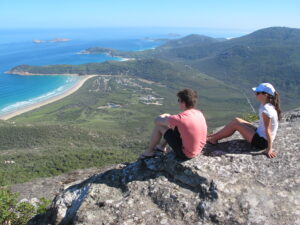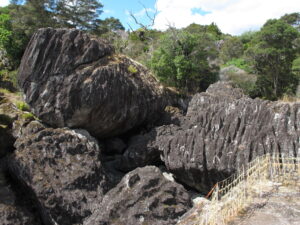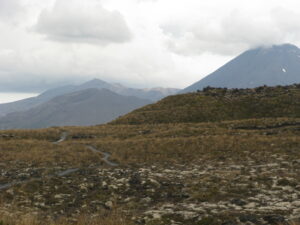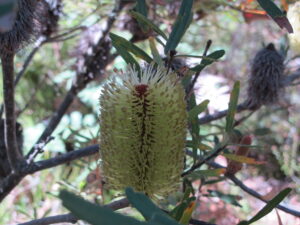Two sunny days in a row. Temperatures climbing to 60 F (about 15 C). Trees budding out. It’s starting to feel like spring down here.Crowds enjoying the vivid tulip display at Botanic Garden
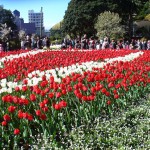
In the spring, many city dwellers know to throng in the harbor area, for a good stroll, cycle, layabout or just a convivial pint in the warming sun. Others prefer the natural splendor of two areas we visited those days: the Wellington Botanic Garden and the newly re-named forest preserve, Zealandia.
The Botanic Garden covers over 60 acres on the auspiciously named Druid Hill, on the side that faces away from Wellington harbor. That makes it about the size of the Dallas Arboretum, but on a far steeper terrain. Dating from the mid-nineteenth century, the Garden features many exotic trees and plants, floral gardens and dozens of trails snaking up and down the hillside.
Some of these trails are secluded and rarely walked, kept mostly wild like native bush; some pass through highly cultivated and landscaped sections like the Rose gardens and are well travelled by visitors. The diversity makes it somewhat different from other Botanic gardens we have visited, even in New Zealand, gardens which are mostly cultivated and meticulously groomed.

The Garden is a key tourist attraction in the city, but one to which Wellingtonians also flock for an outing. Still, even on such a lovely weekend day, after months of less congenial weather and with thousands of city dwellers about, it was only crowded down in the valley area where arrays of tulips displayed extravagant colors and heralded springtime.
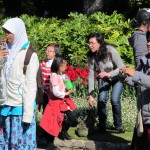
There a hodge-podge of locals, of many ethnicities and ages, ogled tulips like, well, tourists, socialized with friends and snapped photo after photo. Parents kept trying to position their wriggling children just right to get them in the frame against the brilliant colors.
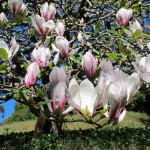
Walking out of the valley area and around the hillside for a couple of hours, we were delighted even more by the flowering trees and bushes: one pathway passed through the diverse tints of camellias, another along the brilliant pinks and whites of the tulip trees and magnolias. One delightful section curved through an endless variety of flowering fuchsia. The new succulent tract was succulent. Even the greenery had donned new coat of spring green to attract the eye.
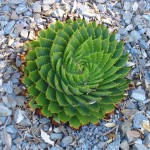
We climbed to the top of Druid Hill where the city Cable Car stops for visitors out of downtown. From there, it was an easy walk home, for we live on the city-side of Druid Hill, just a fifteen minute walk away. It’s our nearest park and green space, one we’ve already visited in worse weather, and a backyard that offers a very attractive reason to live right where we are.
The next day, for the first time, we visited Zealandia, a much wilder environment a fifteen minute ride from us, though one carefully developed in its own way. In 1995, the city recognized the value of turning a large, deep bowl of forest-land into the Te Kopahou wildlife sanctuary. The bowl contained a water catchment that had been a reservoir for the city, controlled by two now “de-commissioned” dams.

The highly innovative aim was to restore native plant life and offer a safe haven for New Zealand’s unique native animals, particularly birds and tuatara lizards, who were rapidly becoming extinct. So they began to remove the predator animals such as cats, possum and rodents that had been introduced to New Zealand in the 19th century and had long been endangering native species. They also re-introduced native trees and bush, such as the Northern Rata.
To keep the good things in and the bad things out, the city surrounded the bowl with an 11 kilometer fence running almost vertically up the steep hillsides and then along the dominant ridges. About 10 feet tall, this mesh wire perimeter was at the time a unique achievement in preservation, creating an effective cloister for a wide variety of native species.
And the preserve appeared to have broad support in the community. Every 10 feet or so, a wood pylon anchors the perimeter fence. On each post can see a small nameplate honoring a donor to the reserve.
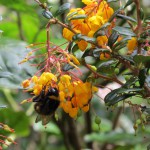
The success of the Wellington effort fostered many other such areas around New Zealand. Three years ago, we visited one of them, Kapiti Island, off-shore about one hour north of Wellington. As an island, of course, it offered a natural border against predators once they were removed. The number of visitors is limited to avoid added harm, but you can book passage to it and readily see a host of native animals and plants that have otherwise disappeared from the country.
Wellington, by contrast, encourages visitors to its preserve. It even re-branded the place as Zealandia – with lots of marketing, free shuttles and outreach – to encourage locals and tourists alike to experience a more authentic landscape and see some of the glorious animals that they could lose. More attention presumably would bring in more funding through admissions or contributions, and help sustain the ongoing work of the reserve.
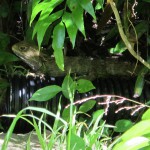
And it is clearly a lot of work. The 32 kilometers of trails/tracks include a wheelchair-accessible walkway with extensive educational signage on the valley floor, well-maintained trails even on the steep routes to the ridge, plus markings throughout to steer hikers and to help spot wildlife. Thousands of short, numbered stakes along the trails, for example, allow you to record the location of a particular animal you encounter. They’ve recently added a huge new enclosure to foster the repopulated lizard, the tuatara, some of which seem to know where to set themselves on the margins of the thickly wooded space so visitors can marvel at them. One volunteer walking near us pointed her favorites out.
We had a wonderful time. From 10:30am till about 4pm, we tramped along 6 – 7 miles of densely wooded trails, dawdling over and over again to listen to a chorale of birdsong. We caught the flash of a tail as one of the tuatara skittered into a burrow far from that enclosure, and peered into the bush to watch rare native birds flit about (oh, the Whitehead; there, the Saddleback; what the heck, the huge thrumming flight of the kereru pigeon).
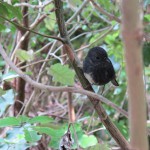
We walked along some of the fencing at the top of the ridge, with a vista over the city, then stopped to picnic at a convenient bench on the descent, with a view over the forested valley instead. There we met a retired cellist and his wife who were frequent visitors to the preserve, had just completed a six-day trek on Tasmania (at the age of 82) and frequently repaired the perimeter fence themselves. While we ate, an avid North Island robin hopped about our feet, a typical behavior of native species which developed with few natural predators. The kaka parrot back on Kapiti enjoys scavenging in people’s backpacks and roosting on their heads; here several dropped by to greet us.
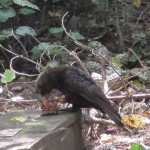
Down at the valley floor, near the lake, in addition to spying the enclosed tuatara, we watched the rare pakehoe – which looks like an overgrown kiwi – grazing on a grassy area, plus countless shags nesting over the lake, and several native ducks.
By day’s end, we regretted it was time to leave, so we signed up as members, planning to return often.
At the farmer’s market early Sunday, just a few blocks from home, a Wellingtonian woman with her banana-laden tot at her heels said hello and asked about us. We explained we were staying in town for a while, and so on. She commented that Auckland, by contrast, was just a big city where everything seemed far apart. But , here in the cool little capital city of Wellington, there was so much to do and enjoy – music, theatre, nature – and all so close. Our two sunny spring days in the Botanic Garden and Zealandia certainly confirmed our choice of cities.
(And for more pictures from New Zealand, CLICK HERE to view the slideshow at the end of the New Zealand itinerary page.)



